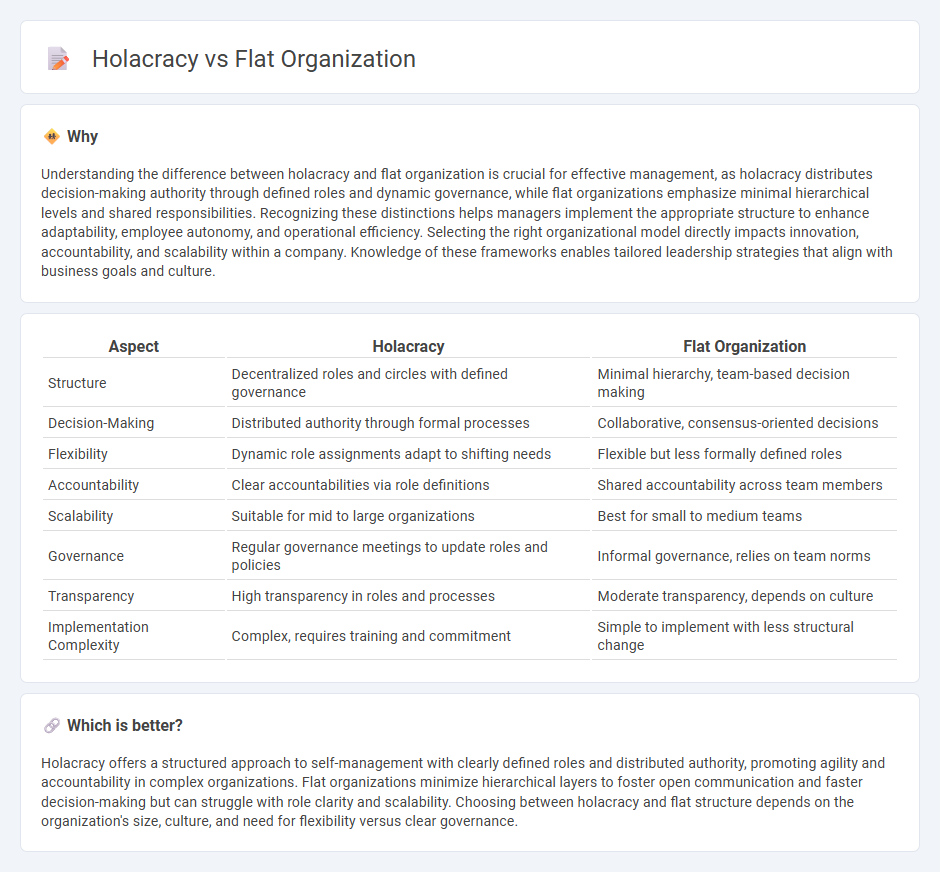
Holacracy is a decentralized management system that replaces traditional hierarchies with self-organizing teams, enabling faster decision-making and increased employee autonomy. Flat organizations minimize management layers to promote open communication and collaboration, fostering innovation and agility. Discover how these management models can transform your workplace dynamics.
Why it is important
Understanding the difference between holacracy and flat organization is crucial for effective management, as holacracy distributes decision-making authority through defined roles and dynamic governance, while flat organizations emphasize minimal hierarchical levels and shared responsibilities. Recognizing these distinctions helps managers implement the appropriate structure to enhance adaptability, employee autonomy, and operational efficiency. Selecting the right organizational model directly impacts innovation, accountability, and scalability within a company. Knowledge of these frameworks enables tailored leadership strategies that align with business goals and culture.
Comparison Table
| Aspect | Holacracy | Flat Organization |
|---|---|---|
| Structure | Decentralized roles and circles with defined governance | Minimal hierarchy, team-based decision making |
| Decision-Making | Distributed authority through formal processes | Collaborative, consensus-oriented decisions |
| Flexibility | Dynamic role assignments adapt to shifting needs | Flexible but less formally defined roles |
| Accountability | Clear accountabilities via role definitions | Shared accountability across team members |
| Scalability | Suitable for mid to large organizations | Best for small to medium teams |
| Governance | Regular governance meetings to update roles and policies | Informal governance, relies on team norms |
| Transparency | High transparency in roles and processes | Moderate transparency, depends on culture |
| Implementation Complexity | Complex, requires training and commitment | Simple to implement with less structural change |
Which is better?
Holacracy offers a structured approach to self-management with clearly defined roles and distributed authority, promoting agility and accountability in complex organizations. Flat organizations minimize hierarchical layers to foster open communication and faster decision-making but can struggle with role clarity and scalability. Choosing between holacracy and flat structure depends on the organization's size, culture, and need for flexibility versus clear governance.
Connection
Holacracy and flat organization share a focus on decentralizing authority by replacing traditional hierarchical structures with autonomous, self-managing teams to enhance agility and employee empowerment. Both models emphasize distributed decision-making, transparency, and collaborative leadership, promoting faster responsiveness and innovation within organizations. Implementing holacracy within a flat organization facilitates clear roles and dynamic governance, aligning operational processes with flat hierarchy principles for improved organizational efficiency.
Key Terms
Hierarchy
Flat organizations minimize traditional hierarchy by reducing management layers, promoting direct communication and faster decision-making among employees. Holacracy eliminates hierarchical roles entirely, replacing them with self-organizing teams governed by defined processes and distributed authority. Explore the nuances between these structures to understand which model best suits your company's needs.
Decision-making
Flat organizations emphasize decentralized decision-making, empowering employees at all levels to contribute ideas and make choices without hierarchical constraints. Holacracy distributes decision-making through defined roles and structured governance processes, fostering clarity and accountability within a self-managed system. Explore how these models transform workplace dynamics and efficiency.
Self-management
Flat organizations eliminate hierarchical layers, fostering direct communication and accelerated decision-making, thereby empowering employees with greater autonomy. Holacracy structures self-management through defined roles and distributed authority, creating a dynamic framework that balances flexibility with clear accountability. Explore the nuances of these models to understand how self-management can transform your workplace efficiency.
Source and External Links
What Is a Flat Organizational Structure? - This webpage explains the definition and characteristics of a flat organizational structure, including fewer management levels and a more informal work environment.
Flat organization - This Wikipedia page describes a flat organization as having few levels of management between staff and executives, differing significantly from tall organizations.
Flat Organizations: Advantages of Eliminating Managers - This article discusses the benefits of a flat organizational structure, including increased flexibility, reduced bureaucracy, and enhanced employee autonomy.
 dowidth.com
dowidth.com